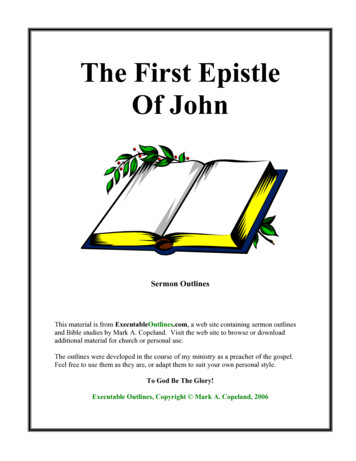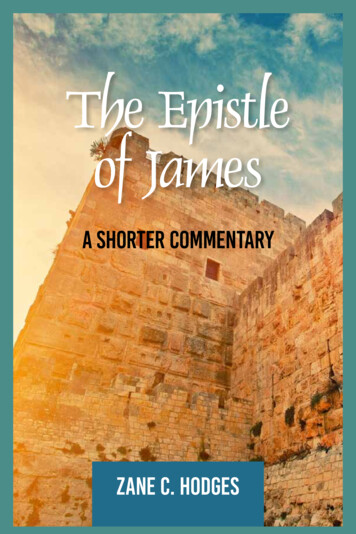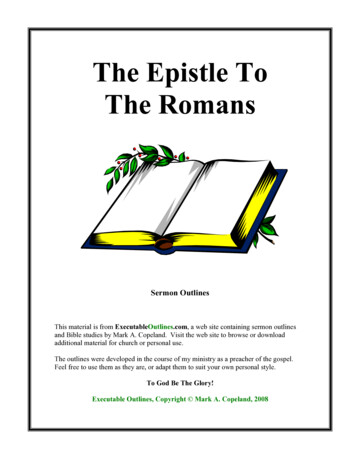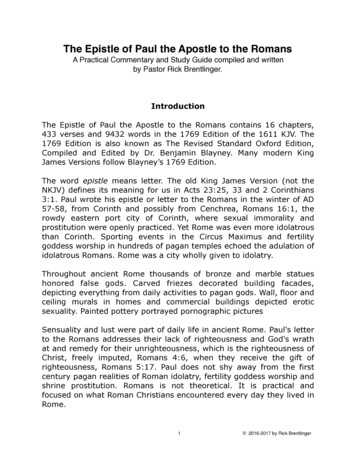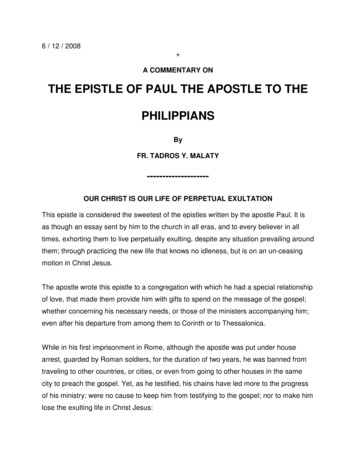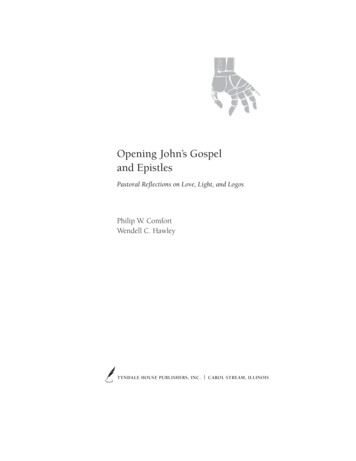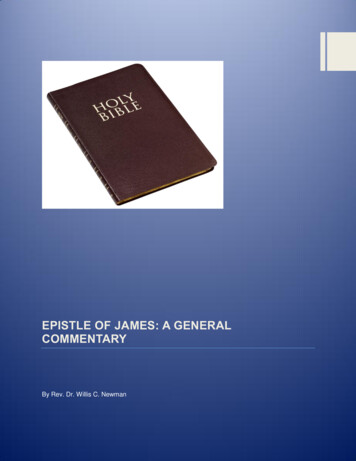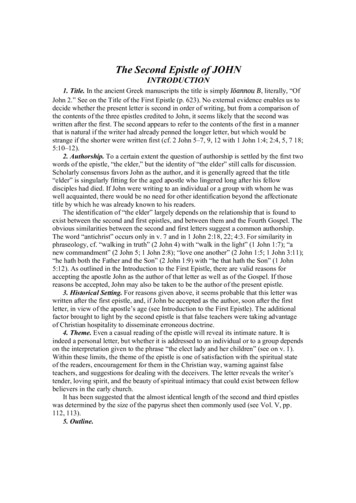
Transcription
The Second Epistle of JOHNINTRODUCTION1. Title. In the ancient Greek manuscripts the title is simply Iōannou B, literally, “OfJohn 2.” See on the Title of the First Epistle (p. 623). No external evidence enables us todecide whether the present letter is second in order of writing, but from a comparison ofthe contents of the three epistles credited to John, it seems likely that the second waswritten after the first. The second appears to refer to the contents of the first in a mannerthat is natural if the writer had already penned the longer letter, but which would bestrange if the shorter were written first (cf. 2 John 5–7, 9, 12 with 1 John 1:4; 2:4, 5, 7 18;5:10–12).2. Authorship. To a certain extent the question of authorship is settled by the first twowords of the epistle, “the elder,” but the identity of “the elder” still calls for discussion.Scholarly consensus favors John as the author, and it is generally agreed that the title“elder” is singularly fitting for the aged apostle who lingered long after his fellowdisciples had died. If John were writing to an individual or a group with whom he waswell acquainted, there would be no need for other identification beyond the affectionatetitle by which he was already known to his readers.The identification of “the elder” largely depends on the relationship that is found toexist between the second and first epistles, and between them and the Fourth Gospel. Theobvious similarities between the second and first letters suggest a common authorship.The word “antichrist” occurs only in v. 7 and in 1 John 2:18, 22; 4:3. For similarity inphraseology, cf. “walking in truth” (2 John 4) with “walk in the light” (1 John 1:7); “anew commandment” (2 John 5; 1 John 2:8); “love one another” (2 John 1:5; 1 John 3:11);“he hath both the Father and the Son” (2 John 1:9) with “he that hath the Son” (1 John5:12). As outlined in the Introduction to the First Epistle, there are valid reasons foraccepting the apostle John as the author of that letter as well as of the Gospel. If thosereasons be accepted, John may also be taken to be the author of the present epistle.3. Historical Setting. For reasons given above, it seems probable that this letter waswritten after the first epistle, and, if John be accepted as the author, soon after the firstletter, in view of the apostle’s age (see Introduction to the First Epistle). The additionalfactor brought to light by the second epistle is that false teachers were taking advantageof Christian hospitality to disseminate erroneous doctrine.4. Theme. Even a casual reading of the epistle will reveal its intimate nature. It isindeed a personal letter, but whether it is addressed to an individual or to a group dependson the interpretation given to the phrase “the elect lady and her children” (see on v. 1).Within these limits, the theme of the epistle is one of satisfaction with the spiritual stateof the readers, encouragement for them in the Christian way, warning against falseteachers, and suggestions for dealing with the deceivers. The letter reveals the writer’stender, loving spirit, and the beauty of spiritual intimacy that could exist between fellowbelievers in the early church.It has been suggested that the almost identical length of the second and third epistleswas determined by the size of the papyrus sheet then commonly used (see Vol. V, pp.112, 113).5. Outline.
So brief a letter, touching upon so many different topics, must be divided into verysmall units in order to list the subjects it contains. However, there are three main sectionsin the epistle.I. Introduction, 1–3.A. Salutation, 1a.B. The tie that binds, 1a, 2.C. Benediction, 3.II. Message, 4–11.A. Praise for faithfulness, 4.B. Exhortation to continue in love, 5, 6.C. Warning against false teachers, 7–11.1. Warning against deceivers, 7, 8.2. Results of continued friendship with deceivers, 9.3. How to deal with heretical teachers, 10, 11.III. Conclusion, 12, 13.A. Hope of an early meeting, 12.B. Greetings from friends or relatives, 13.1 He exhorteth a certain honourable matron, with her children, to persevere in Christianlove and belief, 8 lest they lose the reward of their former profession: 10 and to havenothing to do with those seducers that bring not the true doctrine of Christ Jesus.1. Elder. Gr. presbuteros (see on Acts 11:30). The title may refer to age or toposition, or to both. Since this commentary holds that the apostle John was the author ofthis epistle (see p. 683), it may be observed how fitting is the word “elder” in his case. Atthe time when the epistle was written, c. A.D. 95 (see p. 683), John would be an old manand—according to tradition—being the last surviving apostle, would occupy a veneratedposition in the expanding Christian church. Therefore, when writing to people who werewell acquainted with him, there would be no need for any other identification than thesimple, unpretentious title, “elder.”Some suggest that the title, “the elder,” refers to another person, identified as John thePresbyter, or the Elder John. Support for this view is drawn from the words of Papias(died c. A.D. 163) as reported by the church historian Eusebius. In his EcclesiasticalHistory (iii. 39. 4; Loeb ed., vol. 1, p. 293) Eusebius quotes Papias as follows: “But ifever anyone came who had followed the presbyters, I inquired into the words of thepresbyters, what Andrew or Peter or Philip or Thomas or James or John or Matthew, orany other of the Lord’s disciples, had said, and what Aristion and the presbyter John, theLord’s disciples, were saying.” But it is extremely doubtful whether Papias is herereferring to different persons, both bearing the name of John. It is probable that he isspeaking of one and the same person, John, the beloved disciple. In the first reference, heincludes him among the other apostles who may have left written records; in the second,he appears to include him with Aristion as one from whose own lips he (Papias) hadheard direct testimony concerning the Lord Jesus. Thus the very existence of a distinctPresbyter John is open to doubt; the name may be only another designation for the last ofthe apostles. In this case the title “elder” has still more apt significance when applied toJohn.Elect. Gr. eklektos, “picked out,” from eklegō, “to choose,” probably used here in thesense of ethical eminence. Some have preferred to take the word as a feminine proper
name, Eklekta, but such an interpretation is hardly tenable in view of the clear use ofeklektos as an adjective in v. 13.Lady. Gr. kuria. Two translations of this word are possible. One takes it to be a lady’sproper name, Kyria or Cyria, which is not unknown in Greek inscriptions. But the Greekconstruction makes it improbable that the writer is here using a proper name. The secondpossible translation of kuria is “lady,” a courteous form of address that is the feminineequivalent of kurios, “lord” (see on John 13:13). In this case the phrase used here, eklektekuria, literally means, “to an elect lady.”There still remains the problem of interpretation. To whom was John addressing hisepistle? To this question two answers are advanced: (1) He was writing to a specificChristian lady and her literal children; (2) He was writing to the church, or a church thathe chose to call “an elect lady.” A combination of the above two views may well providethe best solution to the problem. The lady to whom the letter is addressed may have beenthe leader of the church to which John writes, and her “children” may be the churchmembers (cf. 3 John 4). The tenor of the message is more suited to a group of believersthan to an individual, and to mature Christians rather than to children of a certain woman.Her children. These may be the actual children of the “elect lady,” or the members ofthe church to whom the letter is read (cf. 1 John 2:1).Whom. The Greek pronoun is masculine plural, and refers to the elect lady and herchildren of both sexes.I love. The pronoun is emphatic in the Greek. John may also have been stressing hislove because others were not showing affection for the Christians to whom he waswriting (cf. 3 John 9).In the truth. Literally, “in truth,” that is, John loves his friends in the sphere of“truth,” that is, in connection with all that is expounded in the Christian faith.All they. While there may have been those false teachers and upstarts who would notlove John’s readers, he strikes a reassuring note by referring to the genuine believers whowill love those to whom he is writing.Have known. That is, have come to know and are still knowing. John is speaking tothe faithful Christians who have not backslidden.The truth. That is, the Christian doctrine, as expounded by Christ, who is “truth” (seeon John 8:32; cf. John 14:6), and “the Spirit of truth” (John 14:17). Those who hold such“truth” naturally love those who share their beliefs.2. For the truth’s sake. Literally, “on account of the truth.” It is on account of ourcommon acceptance of the truth that we are so closely related to one another by the cordsof love.Dwelleth. Gr. menō (see on 1 John 2:6). Truth must live in the hearts of the believersbefore it can be a unifying factor among them. John is confident that the members of hisChristian community fulfilled the qualification.Shall be with us. Presumably, the truth had also once dwelt in the hearts of those wholater apostatized, but here the apostle expresses firm confidence that truth will perpetuallyabide with the members of his circle. Such confidence does not preclude individual
apostasy, but does proclaim the consistent adherence of the church to its Heaven-sentdoctrine.For ever. Gr. eis ton aiōna (see on Rev. 1:6; 14:11). John never intends to relinquishthe central facts of Christian faith on which his belief is based—the loving nature of God,the incarnation, the atoning death, the resurrected life of the Son of God.3. Grace. Gr. charis (see on Rom. 1:7; 3:24; 1 Cor. 1:3). Apart from John 1:14, 16,17; Rev. 1:4; 22:21, the word charis, “grace,” appears only here in the writings of John,but it is a key word in Paul’s vocabulary. John makes frequent use of agapē “love” (seeon 1 Cor. 13:1), and employs it 18 times in his first epistle. The threefold greeting,“grace, mercy, and peace,” is found in Paul’s pastoral epistles (1 Tim. 1:2; 2 Tim. 1:2;Titus 1:4). John uses it here in a slightly different form.With you. Textual evidence favors (cf. p. 10) the reading “with us.” The apostle isstill including himself and his Christian friends in the message to the “elect lady.”Mercy. Gr. eleos (cf. on Matt. 5:7). The word occurs nowhere else in the Johanninewritings.Peace. See on Rom. 1:7. When grace has awakened a desire for salvation and theheart seeks God for forgiveness and rebirth, then the Lord can give the second gift,“mercy,” or compassion, which would be wasted on one who did not realize his need(Luke 18:10–14). “Peace” comes when the forgiven sinner realizes that he has beenreconciled to God and is no longer under the condemnation of the law, which he hasbroken (see on Rom. 5:1).From God. Literally, “from the side of God,” hence, “from the presence of God,”indicating that God is the source from which grace, mercy, and peace flow to thebeliever.The Father. See on Rom. 1:7, where Paul speaks of “our Father.”Lord Jesus Christ. Important textual evidence may be cited (cf. p. 10) for theomission of “Lord.” The full title “Lord Jesus Christ” does not occur elsewhere in John’swritings. For comment on “Jesus Christ” see on 1 John 1:3. The apostle emphasizes theequality of the Son with the Father and the fact that spiritual gifts proceed to men fromboth persons of the God-head (cf. on 1 John 1:2, 3).The Son of the Father. A unique phrase in Scripture. It emphasizes the centralthought in John’s theology, the divinity of his Master, Jesus Christ.Truth and love. The two elements necessary for the reception of the divinelybestowed gifts of grace, mercy, and peace. The two words “truth” and “love” may betaken as the key words of this short epistle. Common as both words are in the NT,especially in the writings of John, their juxtaposition does not occur elsewhere in the NT.4. I rejoiced greatly. The greeting over, the apostle begins his message. Like Paul inhis epistles (Rom. 1:8; 1 Cor. 1:4; Phil. 1:3; etc.) and like Christ in His letters to the sevenchurches (Rev. 2; 3), John begins with pleasant and praiseworthy matters (cf. 3 John 3).I found. Or, “I have found.” John may have formed his estimate of the faithfulness ofthe believers either by personal observation or, as in 3 John 3, from the reports of visitingbrethren.
Of thy children. Literally, “out of thy children.” This may reflect the possibility thatall church members had not proved faithful. It may also be that John had not met or heardreports of all the “children,” and that others were equally faithful.Walking. Gr. peripateō (see on Eph. 2:2). The word is frequently used in Scripture todescribe the daily conduct (cf. Phil. 3:17).In truth. That is, consistently living under the control of truth, faithfully performingevery duty on earth as part of the walk toward the eternal home (see on 1 John 1:7).As we have received a commandment. Or, “even as we received a commandment.”Although the commandment is not defined, John’s previous writings suggest a referenceto the “new commandment” of love (see on 1 John 2:7, 8; 3:23; 4:21).5. Now. In v. 4 the apostle recorded past satisfaction at the condition of his friends.He now concerns himself with their future conduct.Beseech. Gr. erōtaō, “to ask,” “to pray,” “to beseech,” and “to desire.”Thee. The use of the singular pronoun is cited by some as proof that the recipient ofthe letter was a literal lady, but this reasoning is weakened by the writer’s later use of“yourselves” (v. 8), “you” (vs. 10, 12, a plural as indicated by the Greek). It would appearthat John uses both singular and plural forms of address interchangeably in this letter.Lady. Gr. kuria (see on v. 1).New commandment. See on 1 John 2:7, 8; 3:11. It is probable that the readers of thisepistle had also read John’s first letter.6. This is love. Literally, “this is the love,” that is, this is the love about which I amtalking. John then defines that love as walking “after his commandments.” Love consistsnot only in cherishing kind feelings toward others but in observing right conduct towardour fellows as directed in God’s commandments. These commands, faithfully observed,will result in practical demonstrations of love to our fellows (cf. on 1 John 2:3–6; 3:23;5:3).This is the commandment. The one command concerning love comprehends all theother precepts given by the Lord. This explains John’s alternating use of the singular andplural forms, “commandment” and “commandments” (see on John 13:34; Rom. 13:8).The apostle does not define the commandment, but reminds his readers of it, assumingthat they are well enough acquainted with it to need no more than the reminder.That ye should walk in it. Or, “that ye should keep on walking in it,” that is,molding the life according to the law of love.7. For. Or, “because.” The word connects vs. 6 and 7. The immediate reason forJohn’s stress on “the commandment” is the activity of the “deceivers,” which can beeffectively counteracted only by the practice of the law of love.Deceivers. The troublemakers are clearly identified later in the present verse: they arethose who deny the full implications of the incarnation.Are entered. Rather, “went forth” (cf. on 1 John 4:1).Who confess not. See on 1 John 2:22; 4:3.Is come. The clause reads literally, “those not confessing Jesus Christ coming inflesh.” The form of the Greek verb emphasizes the timelessness of the truth of theincarnation, in contrast with 1 John 4:2, where the historical fact is stressed (see commentthere).A deceiver. Rather, “the deceiver.”
An antichrist. Rather, “the antichrist.” See on 1 John 2:18, 22. John identifies all“deceivers” as being ultimately represented by the great deceiver and antichrist, Satan.All deceptive work proceeds from the devil, no matter what local form his servants maytake.8. Look to yourselves. That is, beware, or take heed (cf. Mark 13:9). The apostle hasissued a general warning against deceivers (2 John 7), but now makes a personalapplication to his readers. It may be noted that he addresses a group, “yourselves,” ratherthan an individual, “thyself” (cf. on v. 5), supporting the thought that John is writing to achurch and not simply to an individual member.We lose not. Textual evidence favors (cf. p. 10) the reading, “ye lose not,” a readingthat harmonizes with the context. John is aware of the possibility of falling from the faith,and wants to open his readers’ eyes to the dangers that confront them (cf. 1 Cor. 9:27;10:12). But the final responsibility rests on the believers themselves, hence theadmonition “look to yourselves.”We have wrought. That is, John and his colaborers have wrought—a reference totheir evangelistic work, the results of which should not be lost to the believers.We receive. Textual evidence favors (cf. p. 10) the reading, “ye receive” (cf. above on“we lose not”). The word translated “receive” may be rendered “receive from,” or“receive back,” that is, from God, the One from whom all good rewards come.Reward. Gr. misthos (see on Rom. 6:23). The “full reward” can be none other thanimmortality, which will be enjoyed only by those who remain faithful unto the end (cf. onMatt. 24:13; Gal. 6:9).9. Whosoever transgresseth. Textual evidence favors (cf. p. 10) the reading,“whosoever goeth before,” that is, whoever tries to go ahead of Christ’s teaching, as theGnostics (see pp. 625, 626) did. The phraseology is strongly reminiscent of John’s firstepistle (cf. on 1 John 3:6).Abideth not. The Greek construction shows that these words qualify “whosoevertransgresseth,” that is, whosoever goes ahead. There is nothing wrong in going ahead solong as one remains within the framework of the Saviour’s own doctrine. But he whotries to go where Christ has not led, places himself outside Christ’s domain, and thusremains not in the doctrine given by Jesus.Doctrine. Or, “teaching” (see on John 7:16). While “the teaching of Christ” may betaken as teaching about Christ, the context clearly favors a reference to the teaching givenby Christ. The expression covers the doctrine personally delivered by the Master and itscontinuation in the preaching of the apostles. The “deceivers” were not willing to limitthemselves to such teachings, but were bent on adding other points of their own, thusgoing beyond what the Saviour Himself had taught.Hath not God. This phrase is reminiscent of the first epistle (cf. 1 John 5:12). Sincethe Son and the Father are one (John 10:30), he who rejects Christ’s teaching also rejectsthe Father’s, and shows that he is trying to outreach God; he is not content with the heightand depth of spiritual knowledge God has placed at man’s disposal, but wants to probeinto other realms that can only contain falsehood.Abideth. Gr. menō (see on 1 John 2:6). To remain and make one’s home in thedoctrine that Christ taught and believed, instead of straying into the realms ofphilosophical speculation or following the deceptive gleams of satanic delusions, is theonly way to ensure a saving relationship with the Father.
Hath both. In developing a positive statement from a negative, John, as his custom is(cf. 1 John 1:6, 7; 2:21; etc.), has enriched his thought. He who wanders outside of truthloses the Father; he who remains has the Father—and also the Son through whom alltruth is revealed (1 John 2:23).10. If there come. That is, when there comes, indicating that visits from hereticalteachers are anticipated.Bring not this doctrine. The phrase serves to definite the visitor and to show that heis a teacher of anti-Christian doctrine, evidently bent on seducing faithful churchmembers.Receive him not. This apparently inhospitable counsel applies only in the case of a“deceiver” and “antichrist” (v. 7), and has no direct bearing on the hospitality thatChristians should cheerfully show to needy friends and strangers (see Matt. 25:35; Heb.13:2). There would be no point in receiving a visitor who was determined to deceive thechurch of God.House. This may refer to the individual’s own home, or to a house where the churchwas meeting.God speed. Gr. chairein, literally, “to rejoice,” used often in the NT as a greeting (seeon Rom. 1:7). It is not possible for a Christian to “rejoice” or to wish God’s blessing on a“deceiver.” He may pray for him, that he may see the error of his ways and turn toembrace the full gospel of Christ, but Christian fellowship is not possible between thebeliever and the false teacher (cf. 1 Cor. 5:9–13).11. Is partaker. Gr. koinōneō, “to have in common,” “to share in.” John makes itclear why we should not entertain false teachers: voluntary association with them willmake it appear that we approve of their teachings, and the undiscerning mightmisinterpret even well-meaning hospitality given to such teachers.12. Many things. In this letter the apostle has dealt only with the most urgent matter,to warn his readers about the danger of false teachers. Many other topics call forattention, but they can best be dealt with more clearly and expeditiously by word ofmouth. John appears to be his own secretary.Paper. Gr. chartēs, “a sheet of papyrus,” a common writing material. The wordappears only here in the NT, though it appears in the LXX of Jer. 36:23.Ink. For a discussion of ancient writing materials see Vol. V, pp. 112–114.Face to face. Literally, “mouth to mouth” (cf. Num. 12:8), John’s emphasis being onthe interchange of speech rather than the mere sight of his friends.Our joy. The apostle’s visit would bring joy not only to the believers but also tohimself. Thus, their joy would be mutual (cf. on 1 John 1:4).13. Thy elect sister. These words may refer to either (1) an actual sister of anindividual “elect lady” (v. 1), or (2) a sister church in the area in which John was thenwriting. The two ideas may be combined as in v. 1 (see comment there).Amen. Textual evidence favors (cf. p. 10) the omission of this word.ELLEN G. WHITE COMMENTS7–11AA 554; SL 64The Third Epistle of JOHNINTRODUCTION
I.II.A.B.C.D.1. Title. In the ancient Greek manuscripts the title is simply Iōannou G, literally, “OfJohn 3.” See on the Title of the First Epistle (p. 623).2. Authorship. Had there been no second epistle, the authorship of the third mighthave been a matter for considerable dispute. But the similarity in style between thesecond and third epistles points to a common authorship, so that once John is accepted asthe author of the second epistle, he may also be accepted as author of the third.3. Historical Setting. The epistle is clearly a personal letter written to an unidentifiedGaius, a faithful Christian who is highly commended for his hospitable charity towardtraveling teachers. Two other characters are named: Diotrephes, a contentious leader; andDemetrius, who is possibly one of the traveling teachers. The picture that emerges fromwhat is written about these three men represents an advanced stage of development in theChristian church, and suggests that this epistle was written after the second, andconsequently still closer to the end of John’s life. The ministry of itinerant preachers, orof visiting brethren, appears to be well established (vs. 5–8); Diotrephes assumes thepower to cast from the church, possibly by a form of excommunication (v. 10), those ofwhom he does not personally approve; and the apostle’s authority has been underminedby the Diotrephes faction (vs. 9–11). All this points to a development of the situationrevealed in the second epistle, and makes the third the last in the trio of letter preserved tous. This is not to say that John wrote no other letters. There is no evidence to prove thatthe letter referred to in v. 9 was the second epistle, although it is an attractive possibility;and there is no way of determining the length of time that passed between the writing ofthe second epistle and that of the third, but it seems probable that the interval was brief,since the letters are so closely related in style and content.4. Theme. This is simple and direct. Whereas the second epistle was written to warnagainst itinerant false teachers, this one is sent to oppose the schismatic tendenciesexemplified by the actions of Diotrephes.It is probable that Diotrephes was the elder of the church and that he had acceptedsome of the false teachings of the Gnostics (see pp. 625, 626). When John wrote to thechurches to rebuke such false teaching, Diotrephes appears to have refused to read theletter to the members (v. 9). Visiting ministers who may have been sent by John werealso refused a hearing, and those who listened to them privately were signallydisfellowshiped by this arrogant man.By writing to Gaius, John endeavors to ensure the delivery of his message to the loyalmembers. He may have been preparing them to accept a change of church elders when heshould come and “remember” the deeds of Diotrephes (v. 10).The same spirit of tender personal affection is evinced in this letter as in the apostle’sother writings, and, over and above the immediate purpose of the epistle, there shines thebeauty of the apostle’s own character and the inspiration that he brings to his readers inall ages.5. Outline.Introduction, 1.Message, 2–12.Good wishes and satisfaction, 2–4.Hospitality praised, 5–8.Hostility opposed, 9, 10.A lesson and recommendation, 11, 12.
III.Conclusion, 13, 14.He commendeth Gaius for his piety, 5 and hospitality 7 to true preachers: 9 complaining ofthe unkind dealing of ambitious Diotrephes on the contrary side, 11 whose evil exampleis not to be followed: 12 and giveth special testimony to the good report of Demetrius.1. The elder. John (see on 2 John 1).Wellbeloved. Rather, simply, “beloved,” a term of affection frequently used in NTgreetings (Rom. 1:7; 16:5; Col. 4:9; etc.), usually in connection with people who arepersonally known to the writer.Gaius. A common name in the Roman Empire, and one borne by at least three otherNT characters (Acts 19:29; 20:4; Rom. 16:23; 1 Cor. 1:14). See on Acts 19:29. There areno grounds for identifying any of these men with the Gaius to whom John is now writing.Nothing is known of this man apart from what is disclosed in this epistle.I love. See on 2 John 1.In the truth. See on 2 John 1.2. Beloved. See on v. 1.I wish. The clause literally reads “concerning all things, I wish [or, “pray”] thee toprosper.” This rendering reveals a more balanced desire on John’s part: he is notsupremely concerned about prosperity and health, as the KJV implies, but has generalprosperity in mind, thus covering spiritual as well as material well-being. John’s prayerillustrates a good habit for Christians to form; remembrance of a friend should stimulateprayer on his behalf (cf. on Phil. 1:3, 4; 1 Thess. 1:2, 3).Prosper. Gr. euodoō, originally, “to have a prosperous journey,” then used in ageneral sense, “to be successful,” “to prosper” (cf. 1 Cor. 16:2). The Lord is notunmindful of our temporal needs. He wants us to succeed in our temporal as well as ourspiritual affairs. A good Christian should be a good businessman, or workman, since, inaddition to natural ability he may also enjoy the blessing of God on his daily duties.Be in health. Gr. hugiainō (cf. our word “hygiene”), “to be sound,” “to be in goodhealth,” and so used by the physician Luke (Luke 5:31; 7:10; 15:27). Paul uses it of thosewho are “sound in faith” (Titus 1:13; 2:2). God is interested in our physical condition,and wants us to enjoy the best of health. Because of the close connection between mindand body, when the soul or character prospers, the body is better able to be healthy (Ex.15:26; Prov. 14:30; MH 241). Conversely, when the health of the body is neglected andbad physical habits are established, the religious life also suffers (MH 280, 315, 319).As thy soul. Here the reference appears to be to Gaius’ spiritual life, which wasstrong. It is possible that his physical condition was not so good. He may have neglectedthe physical concerns of life for the religious. Such neglect is harmful; balance isessential to successful living. The enemy of souls is also well aware of the importance ofbalance, and seeks to drive earnest Christians into extreme positions (MH 318–324). Thecombination of a balanced health program with genuine spiritual advancement willprepare us to overcome the temptations of modern life and help us to meet the highstandard set for entrance to heaven (2T 375, 376).All who are followers of Christ may well make John’s prayer for Gaius their own, forthemselves, their households, and their fellow believers.3. I rejoiced greatly. See on 2 John 4.When the brethren came. The Greek construction implies repeated visits by thebrethren, so that John received frequent reports concerning Gaius.
Testified. Or, “bore witness.” Note that the brethren were willing bearers of goodreports; they did not carry malicious gossip.Truth that is in thee. For comment on the Johannine concept of truth see on John1:14; 8:32. Compare on 2 John 1. Note that “the truth” is “in” Gaius-he has appropriatedit and made it his own.Walkest. Gr. peripateō, “to conduct oneself” (see on Eph. 2:2). Gaius was not contentwith possessing truth; he also practiced the beliefs he held.4. No greater joy. The greatest possible joy fills a Christian worker when he sees themembers of his flock taking a strong and resolute stand for right and truth. He is farhappier than if he heard only of their success in acquiring wealth or position (cf. 2 Cor.7:7; 1 Thess. 3:6).My children. Rather, “my own children.” This may indicate that Gaius was one ofJohn’s own converts (cf. on 1 John 2:1; 2 John 4; cf. 1 Thess. 2:7–12; 1 Tim. 1:2).Walk in truth. Or, “walking in the truth,” that is, con
on John 8:32; cf. John 14:6), and "the Spirit of truth" (John 14:17). Those who hold such "truth" naturally love those who share their beliefs. 2. For the truth's sake. Literally, "on account of the truth." It is on account of our common acceptance of the truth that we are so closely related to one another by the cords of love .



